If you’re familiar with this blog, then you already know how much we love eating local food when we travel. A lot of that traveleating involves street food, which in many countries, has a reputation for being less than sanitary. The Philippines is one of those countries.
Having grown up in Manila, we were conditioned not to eat (too much) Filipino street food because of it’s reputation for being unsafe and unhygienic. If you grew up in Manila, then you’ve probably heard the same urban legends about dirty Pinoy street food. And if you believed those stories like we did, then you’ve probably sworn off street food too.
But if Filipino street foods are supposed to be dirty and dangerous, then why don’t we have any problem eating it abroad? The streets of Hanoi, Penang, and Hong Kong aren’t any cleaner than Manila’s, yet there we are happily slurping bowls of noodles by the side of the road. And not once have we ever gotten sick.
If we have no problem eating it there, then why can’t we eat it here? Have we been unfair to Filipino street food? Are all the stories untrue? Has it all been a conspiracy concocted by some secret society of restaurant CEOs?!
Those are the questions we sought to answer with this post. Like foreign-born Filipinos who come to the Philippines to discover their roots, we walked the streets of Manila to discover, or should I say, rediscover our passion for Filipino street food. Here’s what we found.
Save This on Pinterest!
No time now to read this guide on Filipino street foods? Click on the save button and pin it for later!
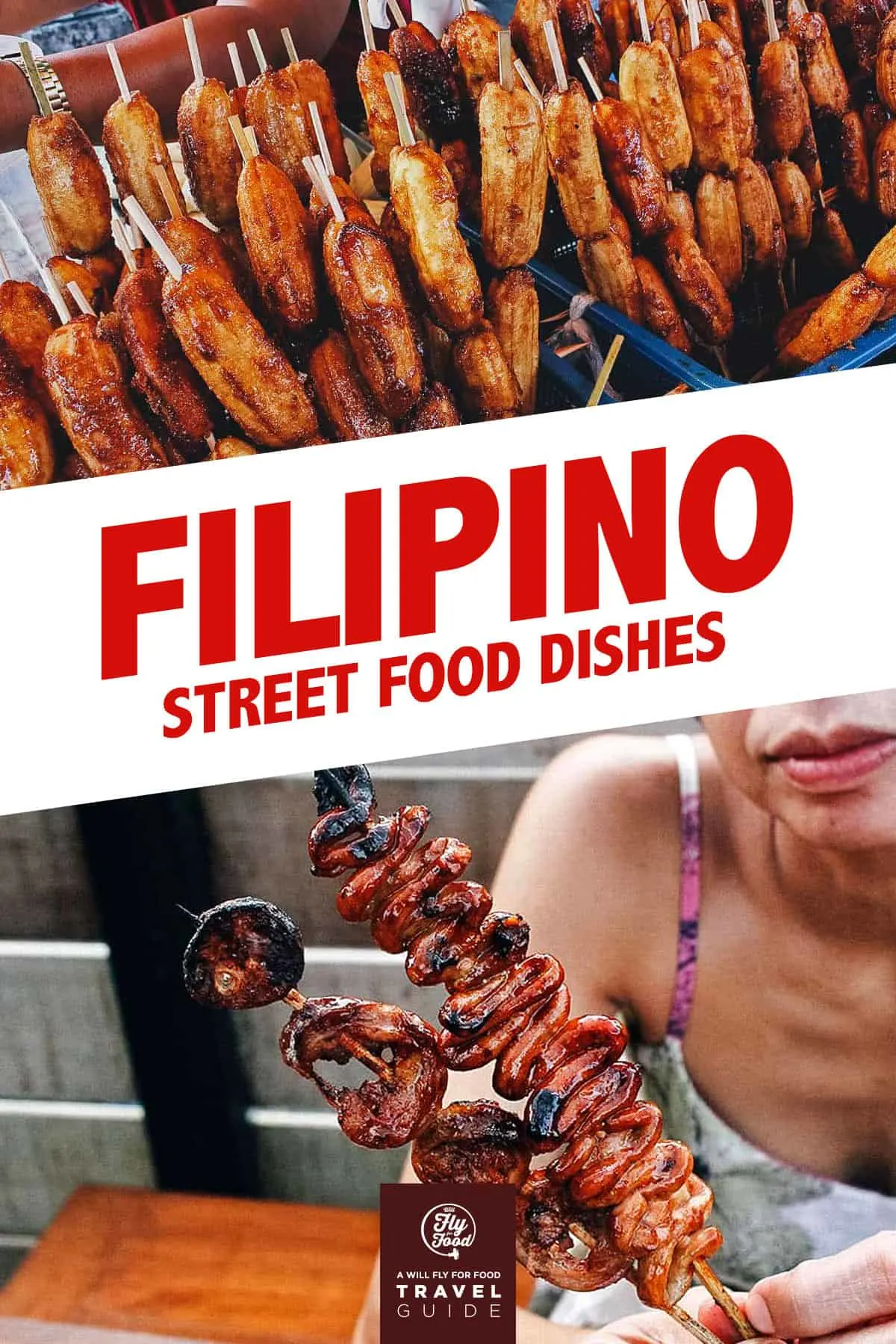
STREET FOOD IN THE PHILIPPINES
1. Balut
I’ve arranged this list in alphabetical order so it’s purely by coincidence that it starts off with one of the most infamous Filipino street foods – balut.
For the uninitiated, balut is a fertilized egg incubated for 14-21 days, boiled, then eaten directly from its shell. It’s typically made with duck eggs, specifically native or Pateros duck eggs, but it can be made with chicken eggs as well if the former isn’t available.
When it comes to weird Filipino street foods fit only for the daring, balut is arguably at the top of the Filipino food chain.
Frankly, I grew up eating balut so I don’t find it the least bit off-putting, but many people do, including Filipinos. Ren for example, loves the “soup” and yolk but she won’t touch the embryo.
Depending on how long it’s been incubated before being boiled, you’ll find balut with the embryo in different stages of development. The ideal incubation period is said to be exactly 17 days. At that stage, the embryo is completely soft and unrecognizable save for its developing feathers.
But I have gotten much bigger embryos that already resemble ducklings! Those typically have harder bones and beaks and are more difficult to stomach, even for seasoned balut eaters. Not to gross you out (if I haven’t already), but I do remember eating one with an already developed beak. It was hard so I had to spit it out.
Balut is often seasoned with salt and/or a chili, garlic, and vinegar mixture, but I’ve always eaten it as is. We Filipinos know how off-putting balut can be for many tourists, so we get a kick out of challenging them to eat it. Most chicken out.
You might also come across a version of balut called “penoy”. These are the balut eggs that don’t properly develop after 9-12 days. Balut penoy is like a hard-boiled egg with no separation between the yolk and egg white, kind of like a semi-scrambled egg still in its shell. Personally, I prefer the real thing.
RECIPE: Sizzling balut
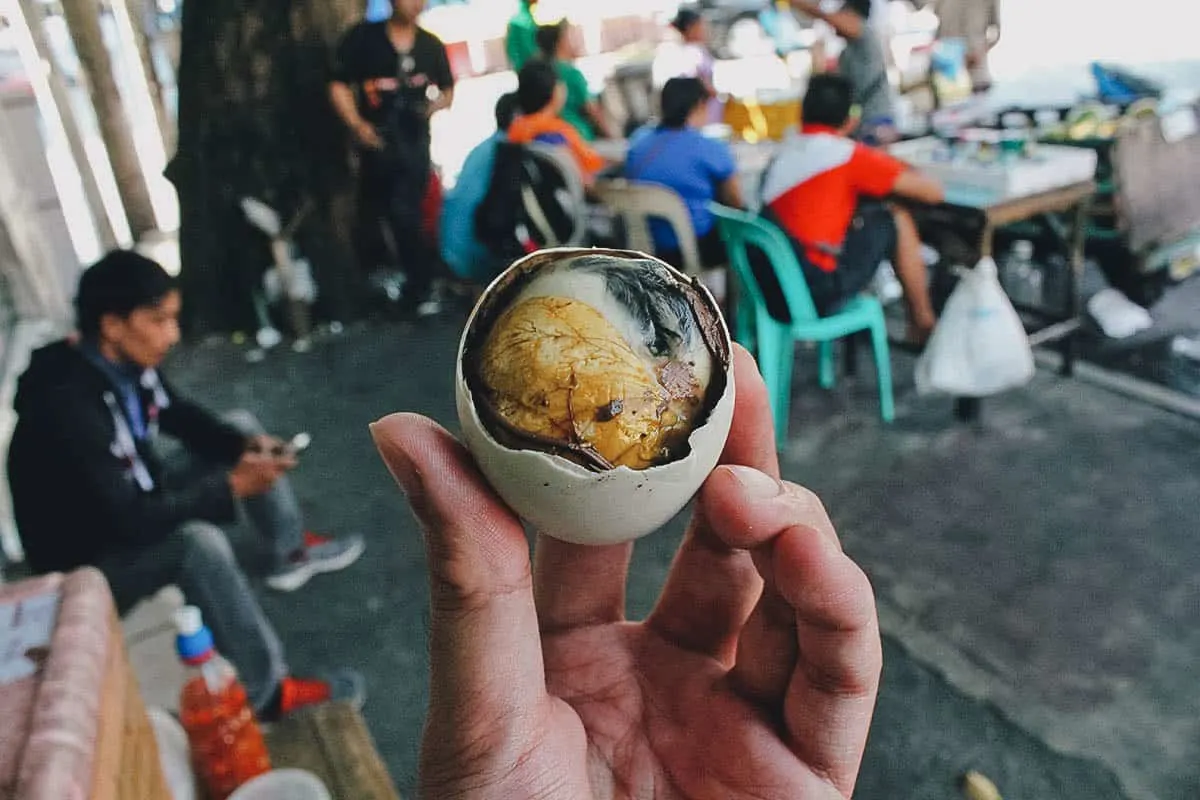
2. Banana Q / Kamote Q
Unlike balut that can be intimidating even to Filipinos, Banana Q (or cue) isn’t scaring anyone away. It’s a skewered deep-fried sweet plantain coated in caramelized brown sugar. Equally popular as street food in the Philippines, it’s something that many Filipinos grew up eating.
RECIPE: Banana Q
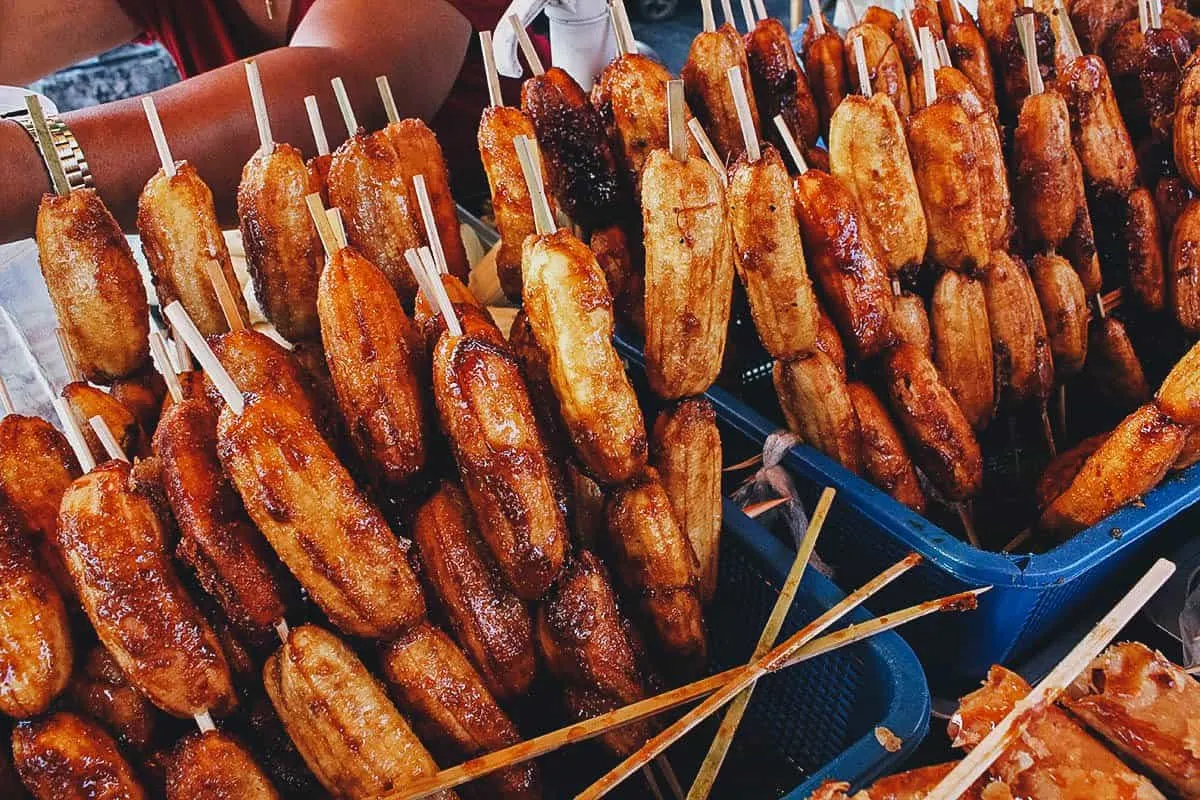
Ren didn’t touch the balut but here she is all giddy to eat the banana q. As described, many Filipinos grew up eating banana q for merienda (midday snack) or as an after-school snack, so it’s something many of us think of fondly. It’s a comforting Filipino snack that brings us back to our childhood.
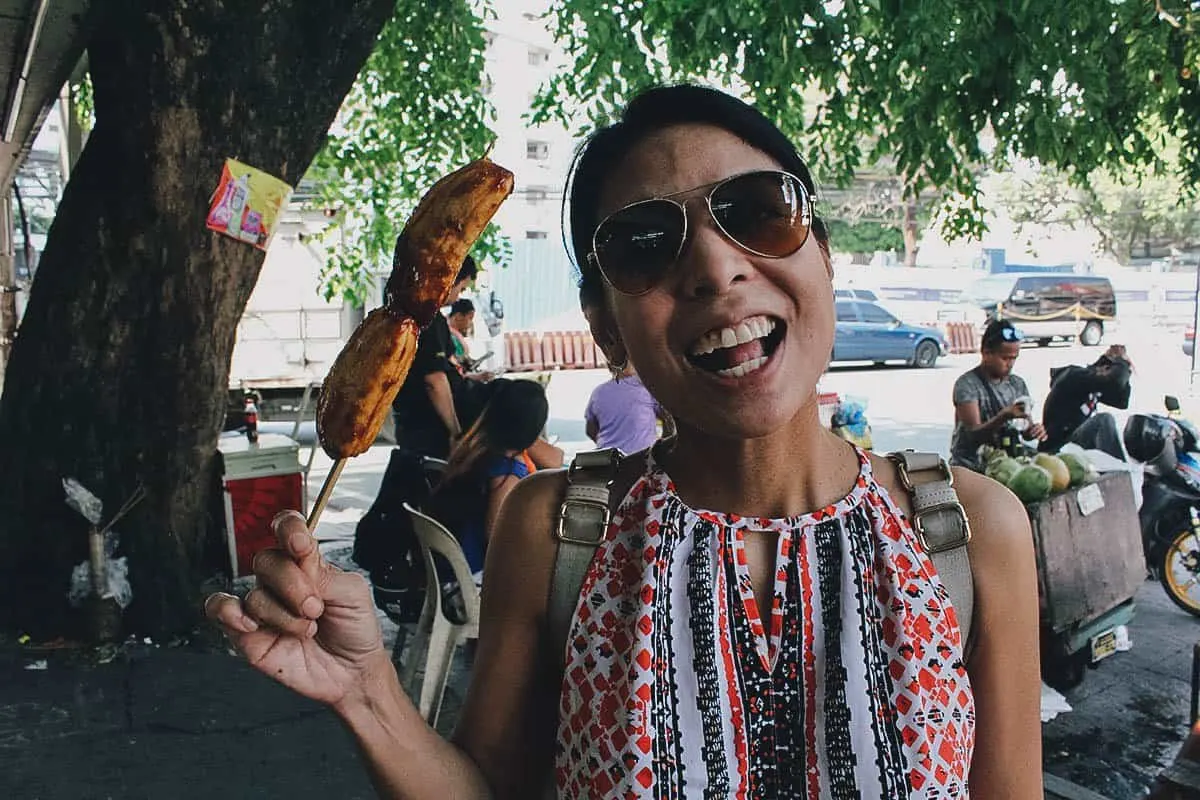
The bananas used to make banana q are called saging na saba or saba bananas. They’re frequently used to make Filipino desserts like turon, halo-halo, minatamis na saging (banana with caramel sauce), and maruya (banana fritter). They’re even used to add sweetness to savory dishes like arroz a la cubana and pochero.
This may sound odd to some westerners, but we Filipinos have a type of ketchup made with saba bananas. Called banana ketchup, it’s a sweetened version of regular ketchup that was invented during WWII due to a lack of tomatoes. Today, it’s arguably more popular than tomato ketchup and is a perfect condiment to oily, deep-fried foods.
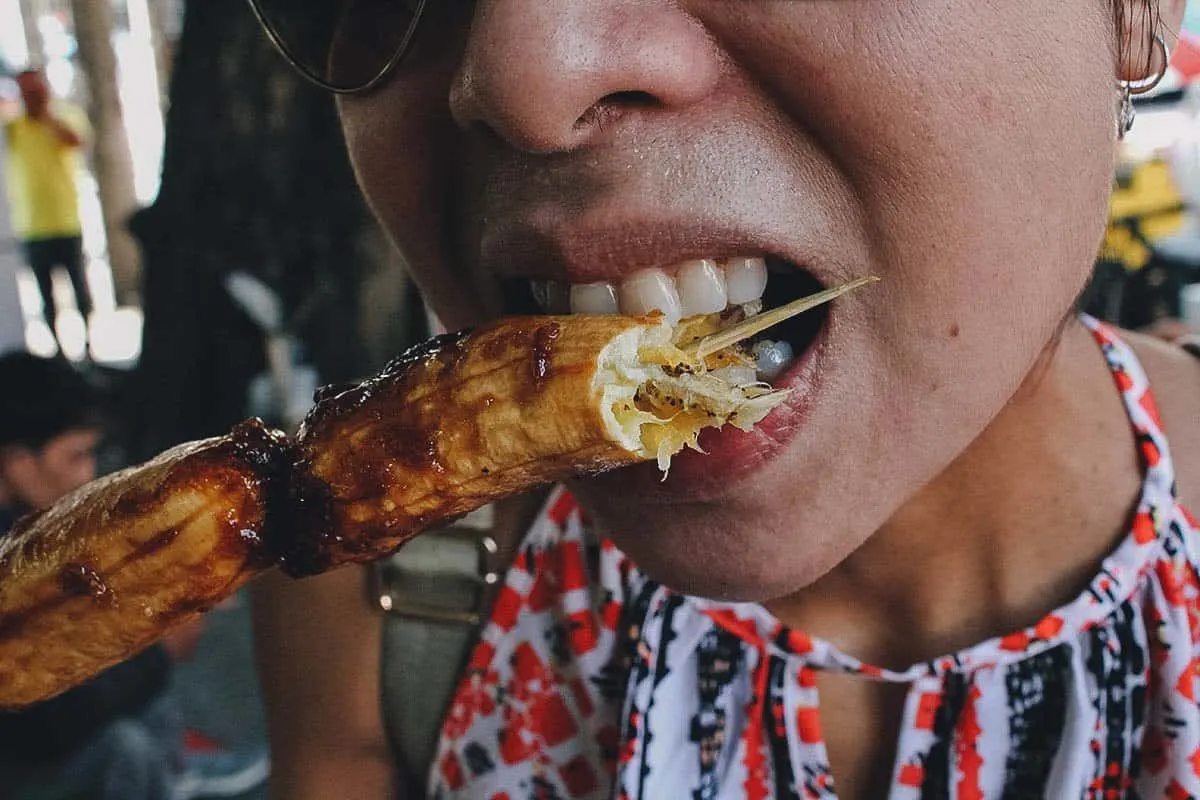
Kamote q is a version of banana q made with camote or sweet potato.
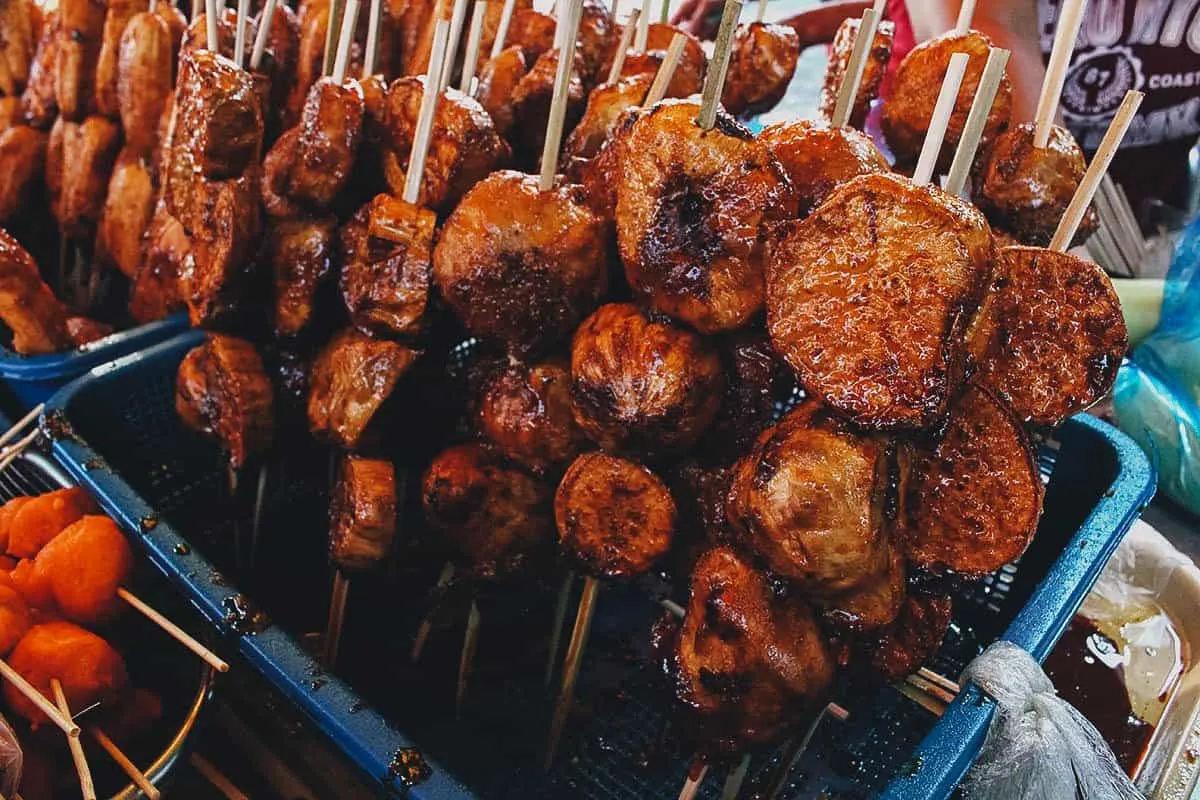
3. Buko
Buko is the Tagalog word for young coconut. I’ve lived in the Philippines most of my life and I never thought of buko as a type of Filipino street food, but I guess you can say it is. Aside from being used in Filipino cooking, fresh buko sold in wooden pushcarts is a common sight in the Philippines, even in big cities like Manila.
Buko vendors will hack the coconut in front of you and serve it with a straw so you can drink it on the spot. If you don’t want a whole coconut, many vendors also offer buko juice made with condensed milk and strands of freshly grated coconut meat.
I actually prefer the latter because it’s usually served chilled, but I find fresh buko juice to be refreshing even at room temperature.
I didn’t know this growing up but buko juice is said to be very good for you as well. Apart from being an excellent way to stay hydrated, it’s also known to prevent kidney stones, reduce sugar levels, regulate blood pressure, and improve digestion.
RECIPE: Buko pandan
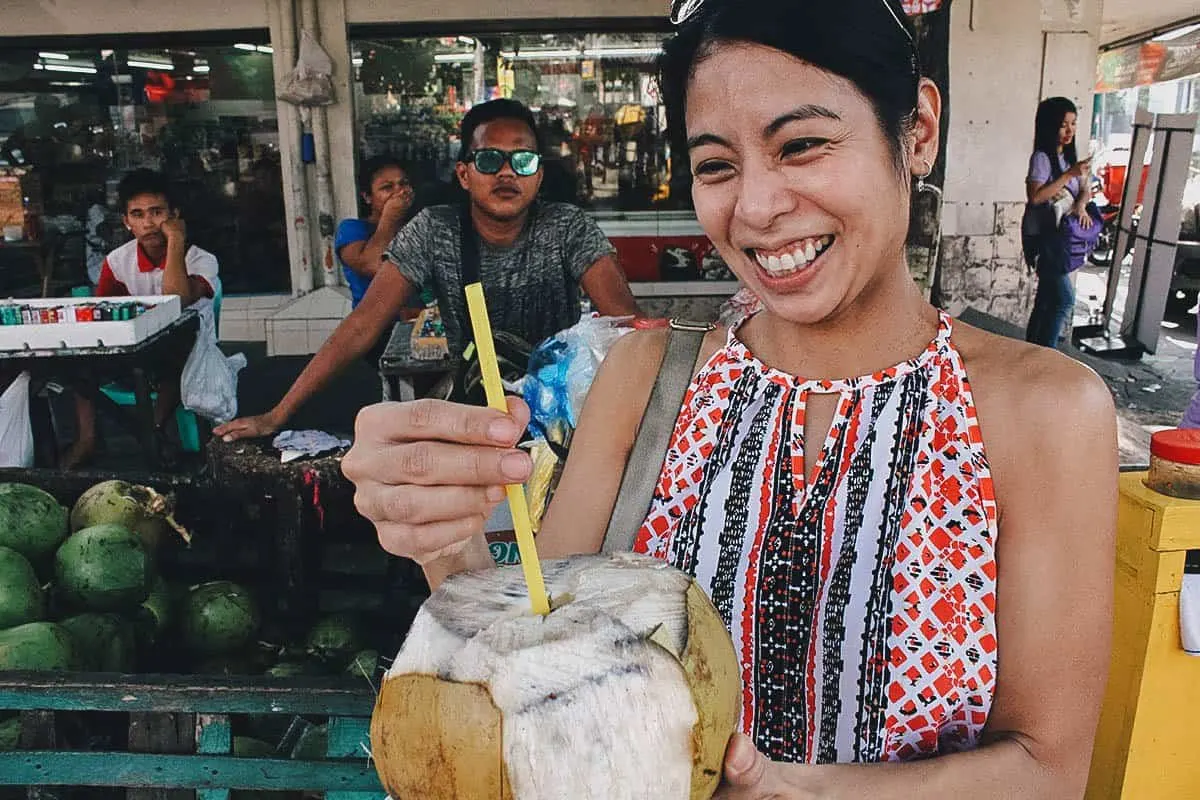
4. Bulaklak
This is an interesting Filipino street food dish, even for locals. Bulaklak refers to pork chitterlings or mesentary. It refers to the folds of tissue that attach the small intestines to the back of the abdominal wall.
What makes this particular bulaklak interesting is how it’s cooked. Bulaklak is typically served as a deep-fried dish called chicharon bulaklak.
I’ve never seen chicharon bulaklak served as a street food but it’s one of the most popular Filipino bar chow dishes. Go to any Filipino bar and chances are you’ll find chicharon bulaklak on the menu.
This particular version however, is called inihaw na bulaklak which means it was grilled instead of being deep-fried. I don’t know where it originated from but it’s nowhere near as ubiquitous as chihcaron bulaklak.
Like many Filipinos, we grew up eating chicharon bulaklak but we got our first taste of inihaw na bulaklak just a few years ago in Bulacan. Recently, we’ve seen a couple of food park stalls in Manila serve it so the trend may be catching on.
As you’d expect, it isn’t crunchy like the deep-fried version but it’s smokey, less sinful, and every bit as delicious with beer.
RECIPE: Chicharon bulaklak
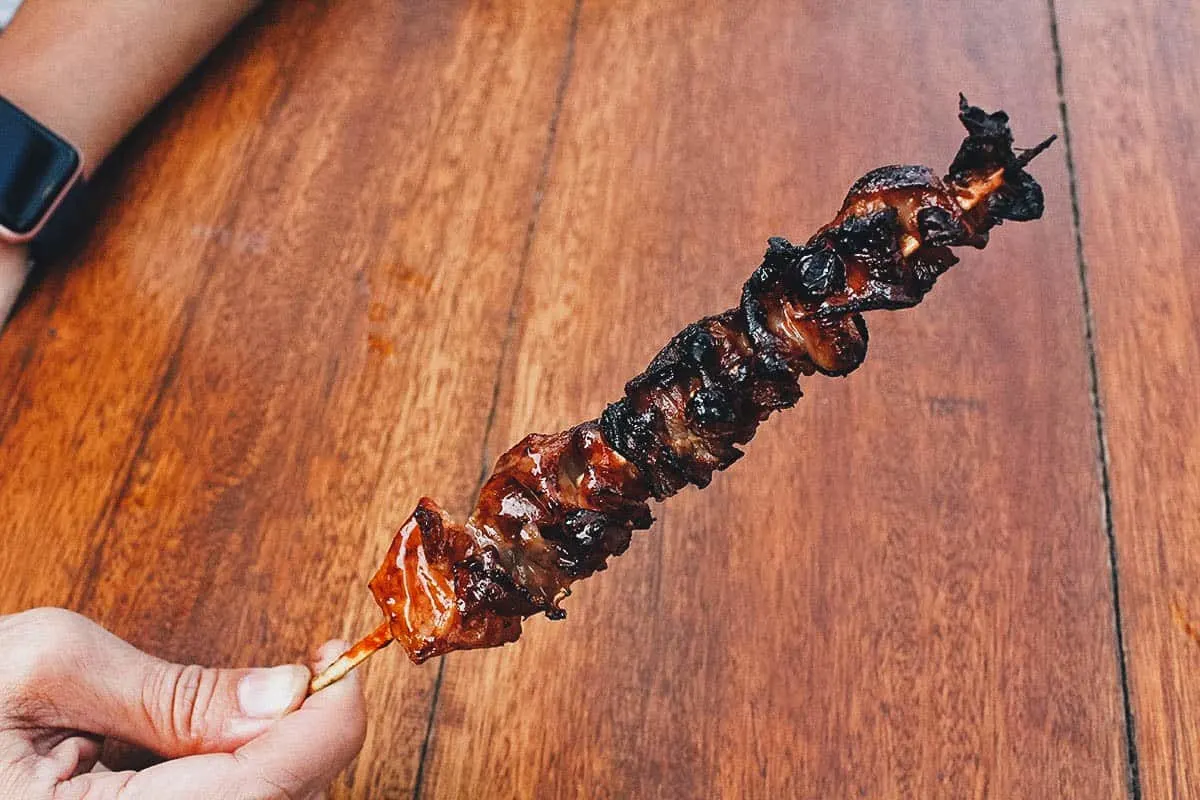
5. Empanada
Like in many Spanish-speaking countries, empanada is popular in the Philippines. Fillings vary greatly but Filipino empanadas often contain ground meat (beef, pork, or chicken), potatoes, onions, carrots, peas, and raisins wrapped in dough that’s either baked or fried.
I’m not sure if empanada is commonly sold as street food in Manila, but in Vigan, which is home to arguably the most famous type of Filipino empanada, it definitely is.
Unlike other varieties, Vigan empanadas are orange in color and much bigger. It gets its color from achuete or annatto seeds which is the same ingredient used to color kwek kwek and tokneneng.
Vigan empanadas are also deep-fried, resulting in a crispy shell-like dough that’s very different from the soft, semi-sweet dough used in other types of Filipino empanadas.
Fillings vary but Vigan empanadas typically contain grated green papaya, mung bean sprouts, shredded carrots, skinless Vigan longganisa (Filipino sausage), and a whole egg.
If you watched the video near the top of this post, the monster Vigan empanada we had was made with two eggs. Like Vigan ukoy, empanadas are typically served with a spiced vinegar dip to help offset the oiliness.
Until a few years ago, you had to go all the way to Vigan to enjoy this type of empanada. Thankfully, it’s become more widely available in Manila in recent years. You can find it at some food park stalls and small restaurant chains specializing in Vigan empanada.
RECIPE: Vigan empanada
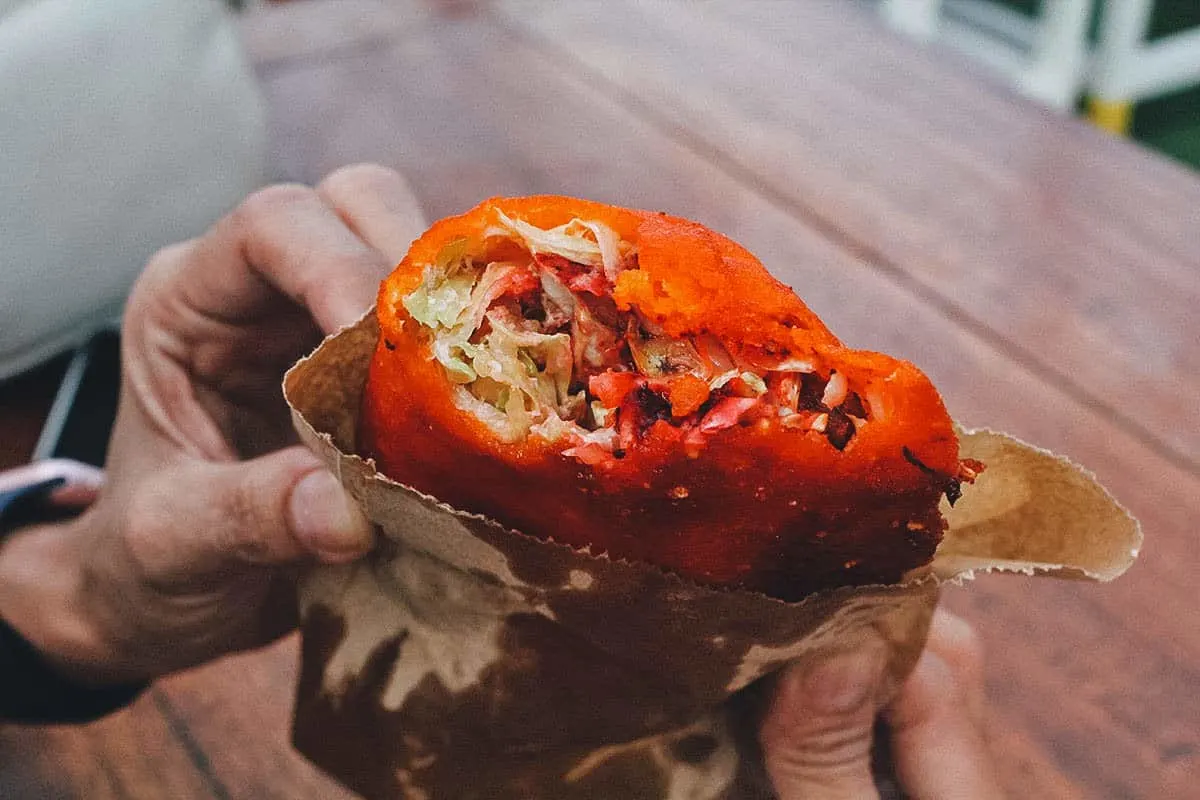
6. Fish Balls / Chicken Balls
If balut is the most infamous Filipino street food, then fish balls are arguably the most iconic. Many Filipinos grew up eating it so for us, fish balls are the quintessential Filipino street food. They’re basically balls of flour made with some type of flaked fish meat.
Of all the Filipino street food dishes we ate for this article, fish balls were the ones I was most excited about. I left for the US at barely 14 so this was probably my first time to have them again in almost 30 years.
Unlike banana q or turon, a stick of fish balls wasn’t something you could easily have at home, at least not the authentic kind. I remember my mom bringing home frozen supermarket fish balls once, but they just weren’t the same.
To be honest, the fish balls we had today were more like that supermarket variety. They were crunchier and bigger, unlike the soft, flat-ish fish balls I remember from my school days.
I pointed that out to Ren and she agreed. These seemed different from the ones we grew up with. Evolution of Philippine street food I guess?
RECIPE: Homemade fish balls
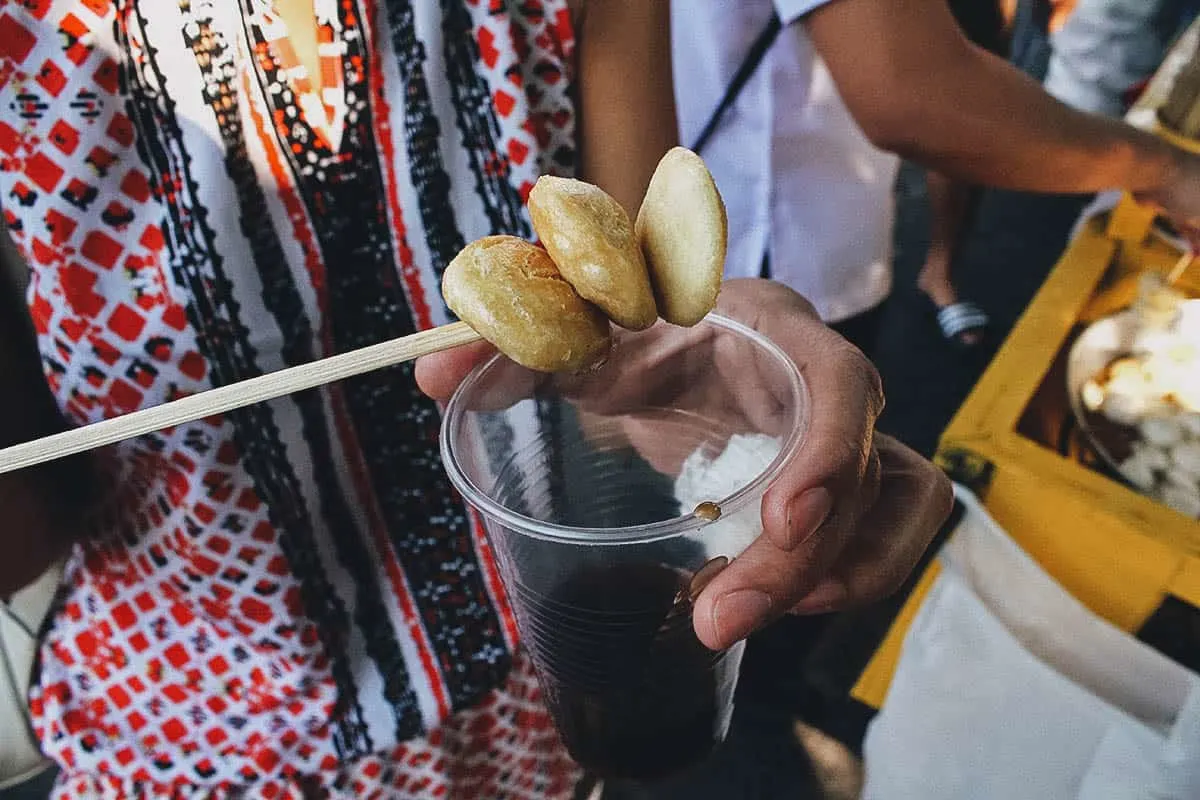
Speaking of street food evolution, these weren’t around in our youth either. We were surprised to find that the fish ball vendors of today also sell chicken balls. They’re bigger and almost double the price of fish balls.
Even though they’re not how I remember them to be, eating fish balls today brought back a flood of fond boyhood memories. Growing up, I remember how pushcart vendors would wait outside our school with pans of deep-frying fish balls. We’d gather around the pan and stab fish balls with thin barbecue sticks before dunking them in one of three sauces.
I didn’t know what was in the sauces back then, but one sauce was brown and sweet, another was spicy (vinegar with chili), and the third was a combination of the two. I always went for the sweet. Good times.
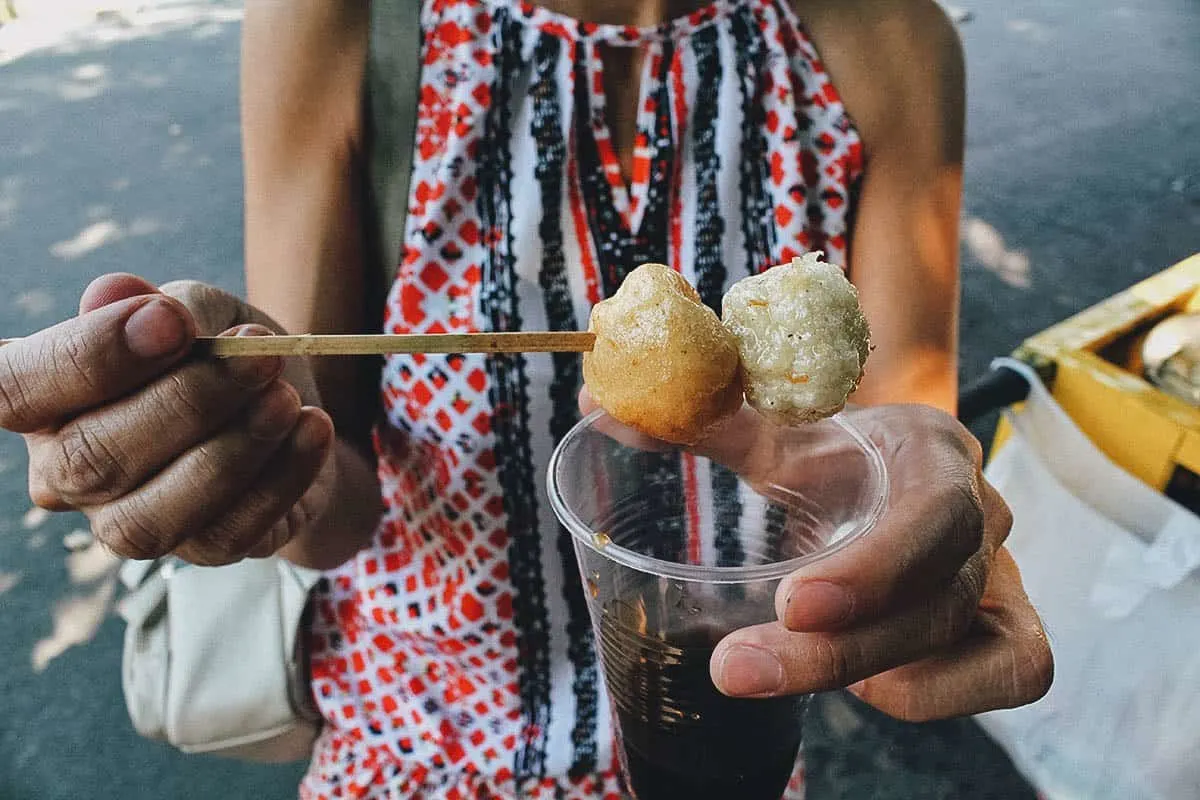
7. Isaw (Pork or Cicken)
Like fish balls, isaw is one of the most iconic Filipino street foods. I wasn’t exposed to it as much growing up but many people say it was a legendary street food at UP Diliman. I read that students from all social classes would line up for their isaw at the many streetside grilleries near campus.
Isaw refers to barbecued pig or chicken intestines that are thoroughly cleaned before being boiled, skewered, and grilled. Pictured below on the left is the pork isaw while to its right is the chicken. Like the other grilled skewered dishes on this list, isaw is typically served with a spiced vinegar dip.
Like walkman, Filipinos have funny colloquial names for chicken and pork isaw as well. Chicken isaw is also referred to as “I.U.D.” because it’s said to resemble older designs of intra uterine devices. Pork isaw is called “mag wheels” because it looks like…well, mag wheels!
RECIPE: Grilled isaw
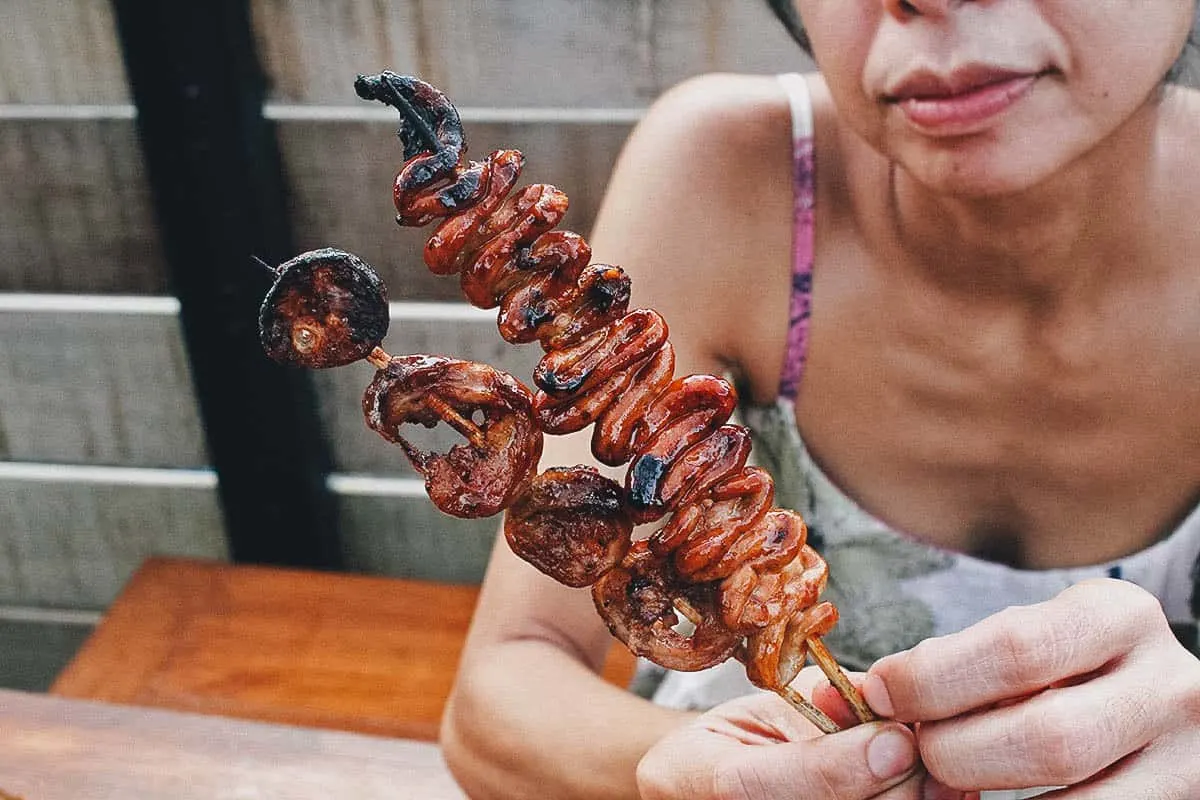
8. Kwek Kwek / Tokneneng
Kwek kwek is a hard-boiled quail egg that’s coated with an orange batter and deep-fried until crispy. They’re pretty much exactly how you’d imagine them to taste, like eggs deep-fried in tempura batter.
The batter itself is flavorless so I have no idea why it has to be orange. Perhaps just to make the kwek kwek look more appetizing? If that’s the reason, then it works.
RECIPE: Kwek-kwek
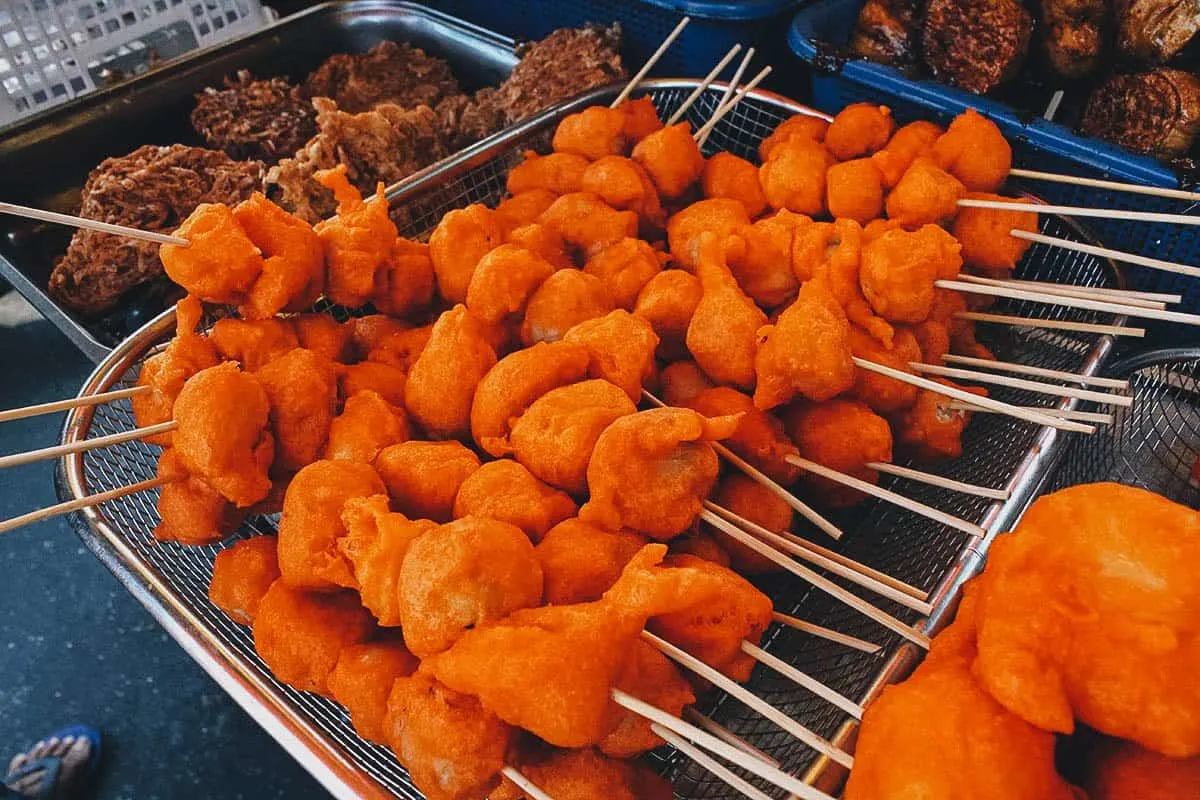
Unlike fish balls that have been around for as long as I can remember, kwek kwek seems to be a relatively new Filipino street food that’s been around only for the last 20 years or so.
Kwek kwek is served with a spicy chili-vinegar dip. You can find it in some bars as well. The bite-sized portions make them an ideal Filipino bar food.
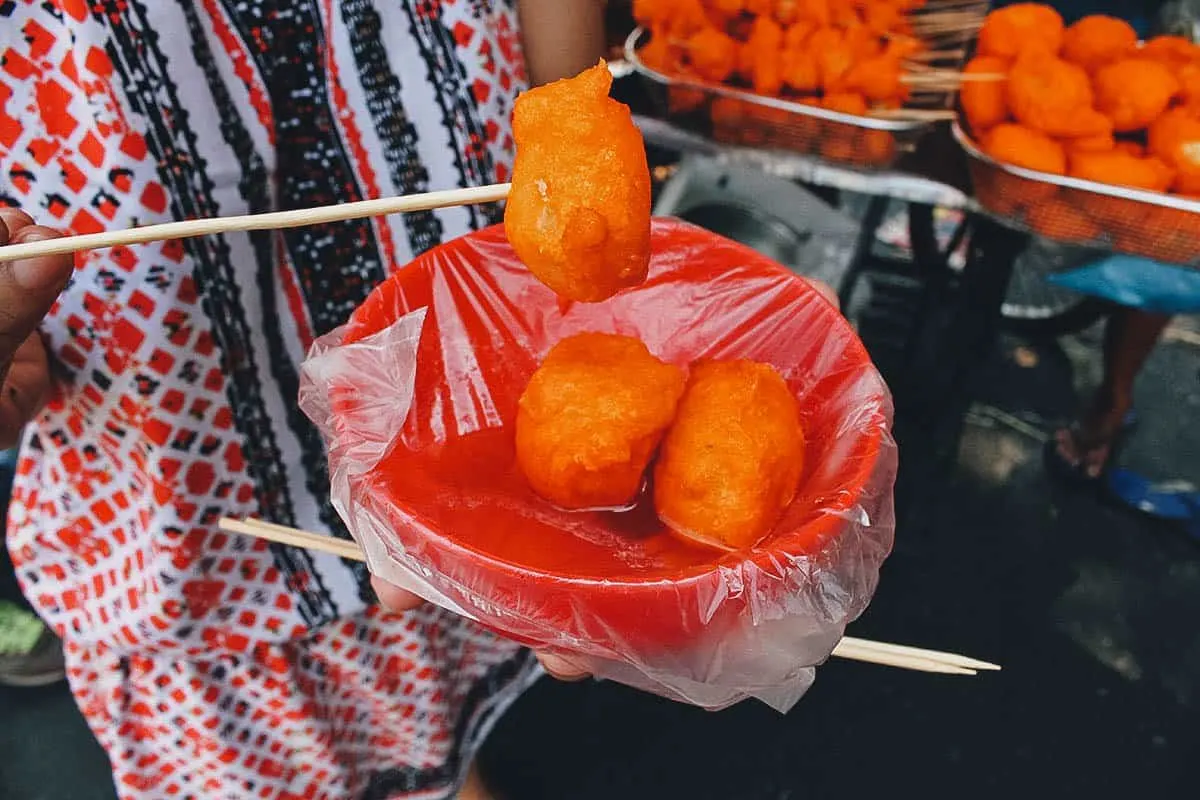
Tokneneng is basically the exact same thing as kwek kwek except it’s made with hard-boiled chicken eggs.
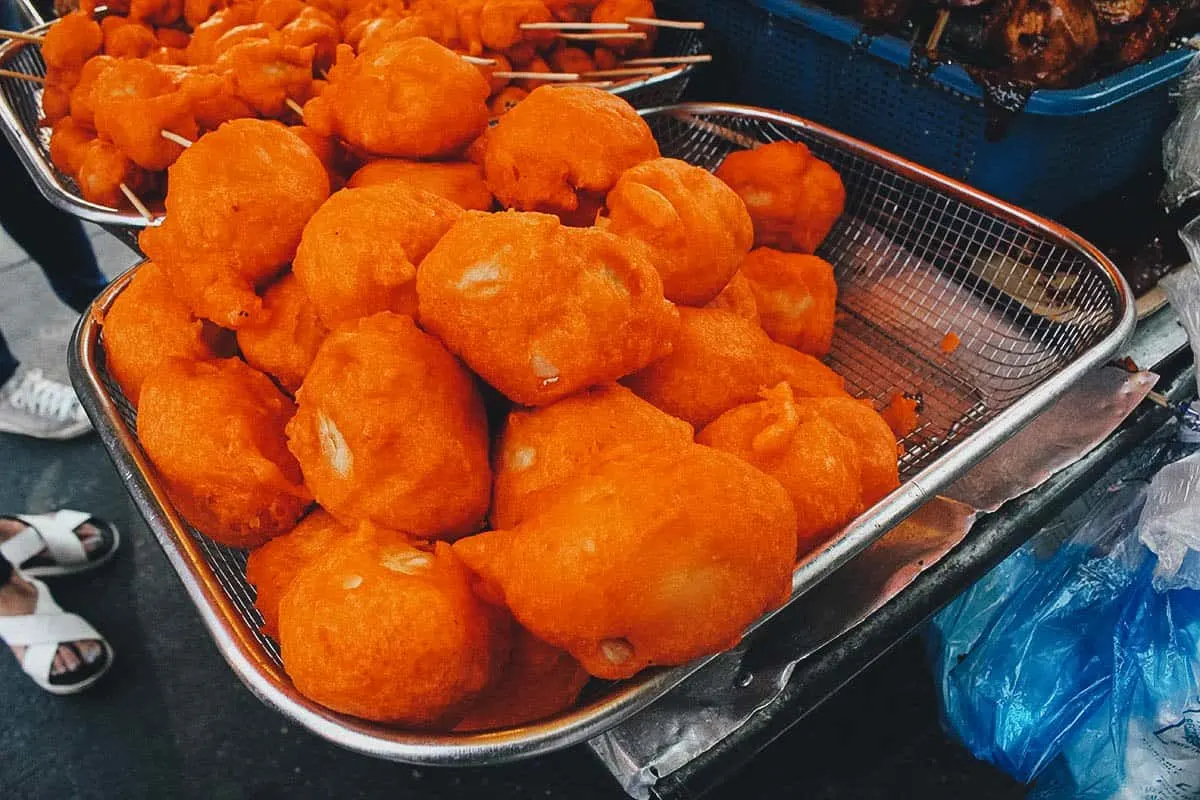
9. Lugaw (Goto / Arroz Caldo)
Lugaw refers to a thick Filipino rice porridge that’s similar to Cantonese-style congee. It’s boiled with strips of fresh ginger and often topped with scallions, crispy fried garlic, and other seasonings.
Lugaw is a popular Filipino street food dish that’s also commonly eaten at home. I remember my dad often eating it whenever he felt under the weather.
If I understand correctly, the term lugaw refers to plain rice porridge. When it’s served with different types of beef and pork offal like tripe, intestines, and tongue, it becomes known as “goto”. When served with chicken, it’s referred to as “arroz caldo”. But they’re all pretty much the same thing – rice porridge.
Whether it be lugaw, goto, or arroz caldo, I like the dish best when paired with tokwa’t baboy. Tokwa’t baboy is a side dish of boiled pork and deep-fried tofu served with vinegar, soy sauce, shallots, and chili. Nothing beats this pairing on a rainy day. Yum!
RECIPE: Lugaw
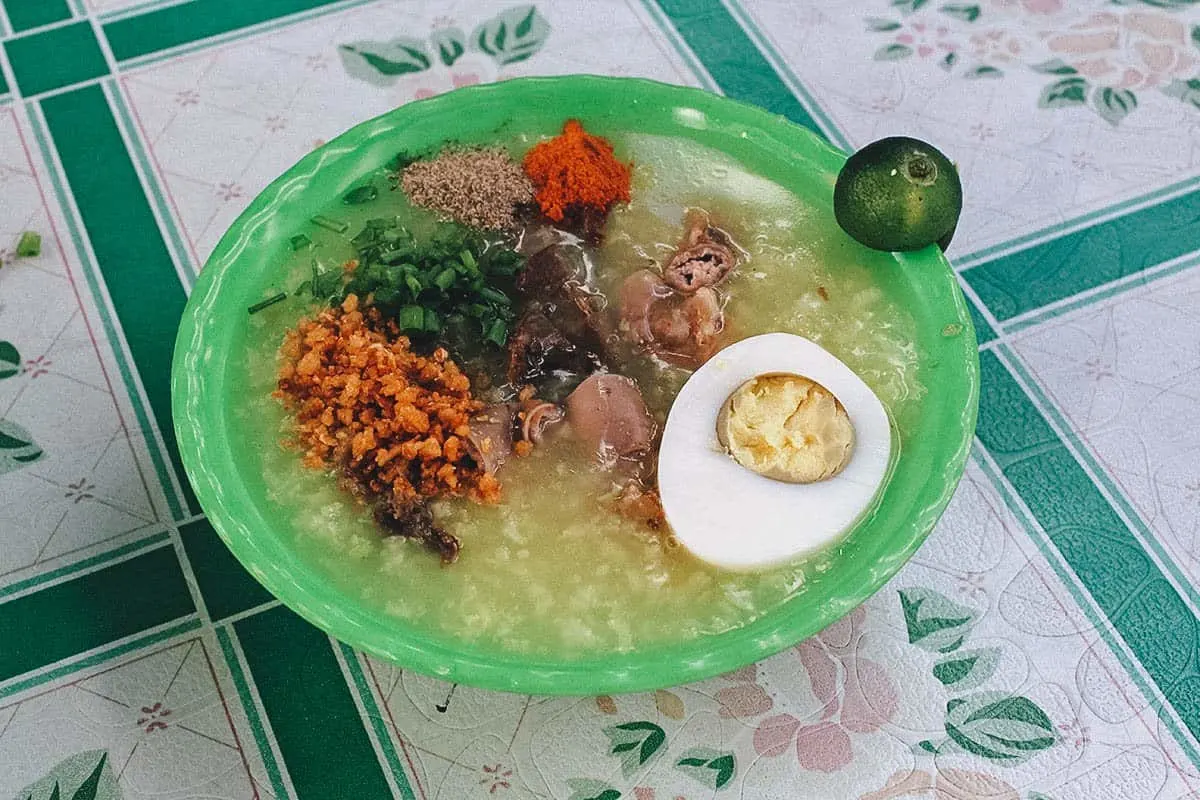
10. Mais
Like buko, I’ve seen mais (corn) sold on Manila’s streets for as long as I can remember but I’ve never really considered it as Filipino street food. Perhaps it’s because of the way it’s presented.
Unlike Mexican elote for example, which is grilled until charred then seasoned with a cream sauce, Filipino mais is basically just boiled corn on the cob. Nothing about the way it’s prepared makes it uniquely Filipino. But if it’s sold as street food in Manila, then technically it is which is why it’s on this list.
RECIPE: Ginataang mais
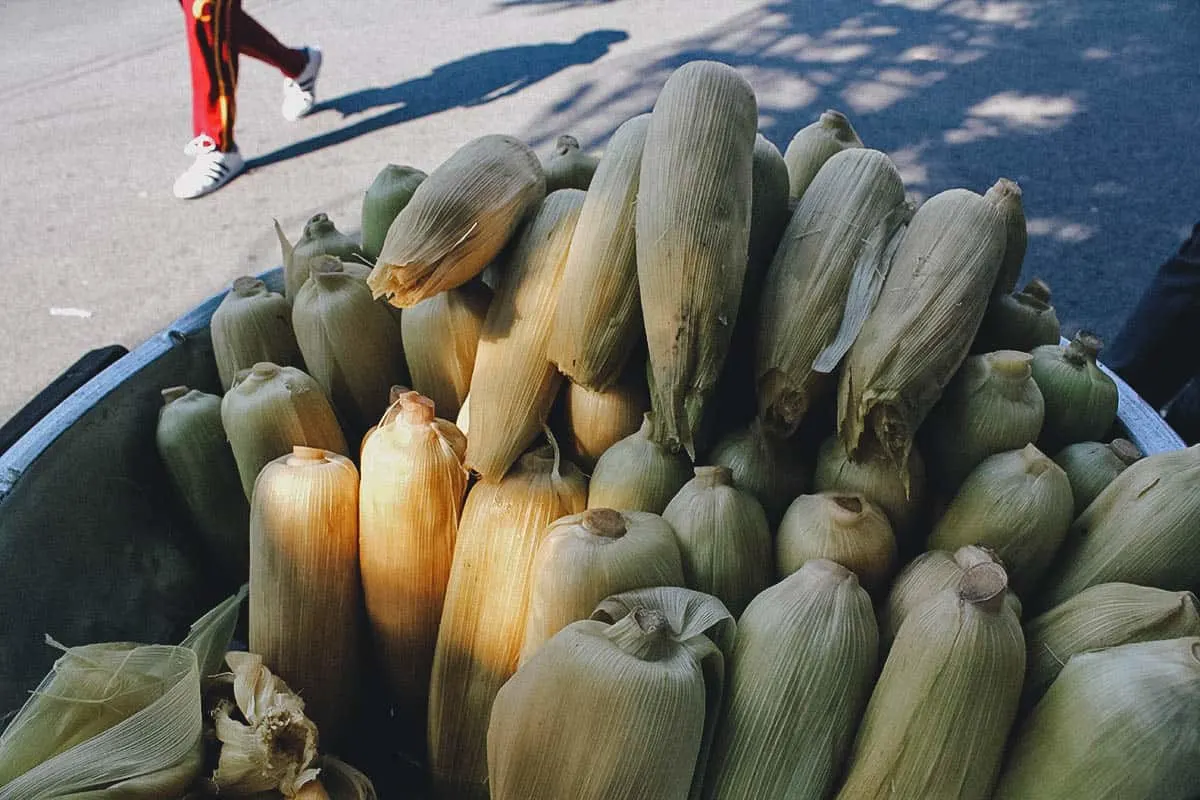
Our mais or boiled corn on the cob. It isn’t the most interesting or exciting of Filipino street foods but it does have its fans.
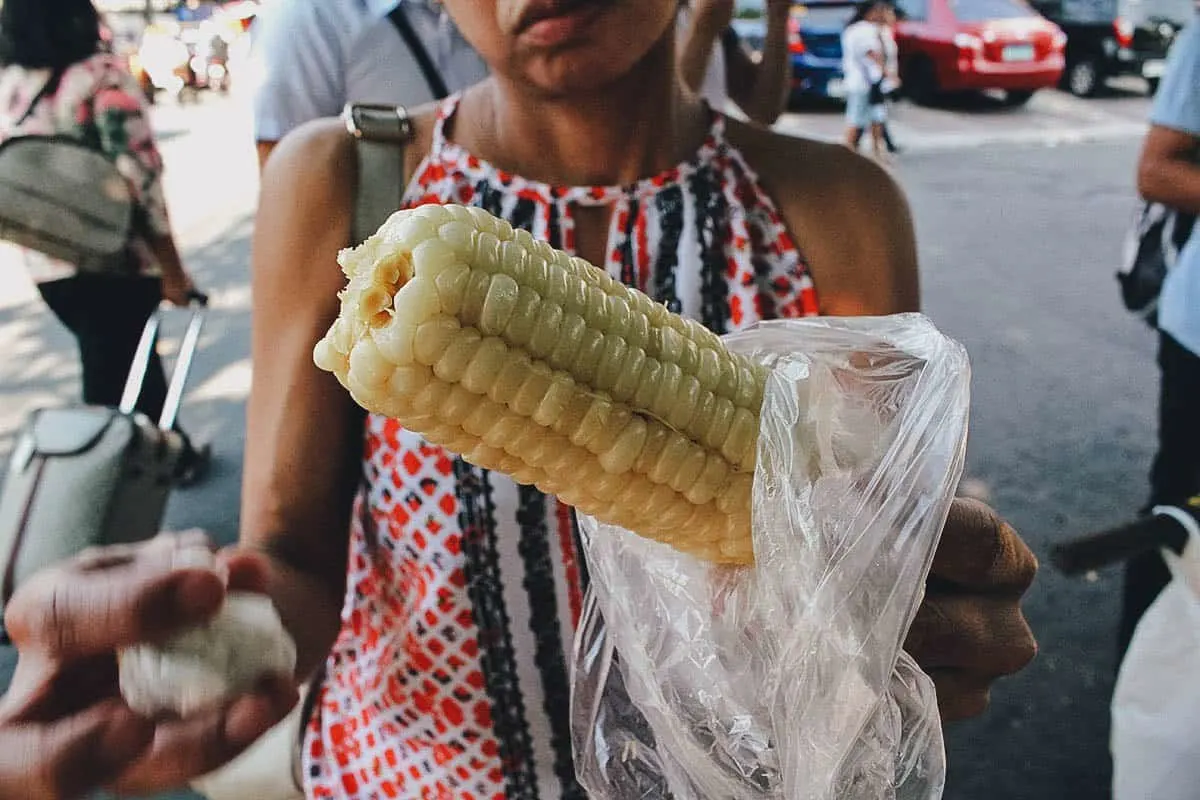
11. Mami
Mami refers to a Chinese-Filipino noodle soup made with wheat flour noodles, broth, and meat like beef, chicken, or wonton. To be honest, I never associated mami with street food. I thought it was a Chinese dish you can only find at restaurants, but as it turns out, it’s often sold as street food in Manila as well.
I never knew this but I just learned after doing research for this post that mami was invented by Ma Mon Luk. Ma Mon Luk was a Chinese immigrant who started selling noodles with chicken broth in Binondo, Manila in the 1920s.
He initially called his dish “gupit”, which is the Tagalog word for “to cut”, presumably in reference to his cutting of the noodles when serving them with the soup. He later renamed the dish “mami” which means “Ma’s noodles”.
Today, the word mami is the blanket term used by all restaurants (and street vendors) to describe this dish.
We both grew up in Quezon City so the Ma Mon Luk restaurant along Quezon Avenue is something we’ve known all our lives. Open since the 1950s, it’s a Quezon City institution that’s still thriving to this day.
Ma died in 1961 of throat cancer, but his legacy will forever live on in this bowl of noodle soup. So cool!
RECIPE: Chicken mami
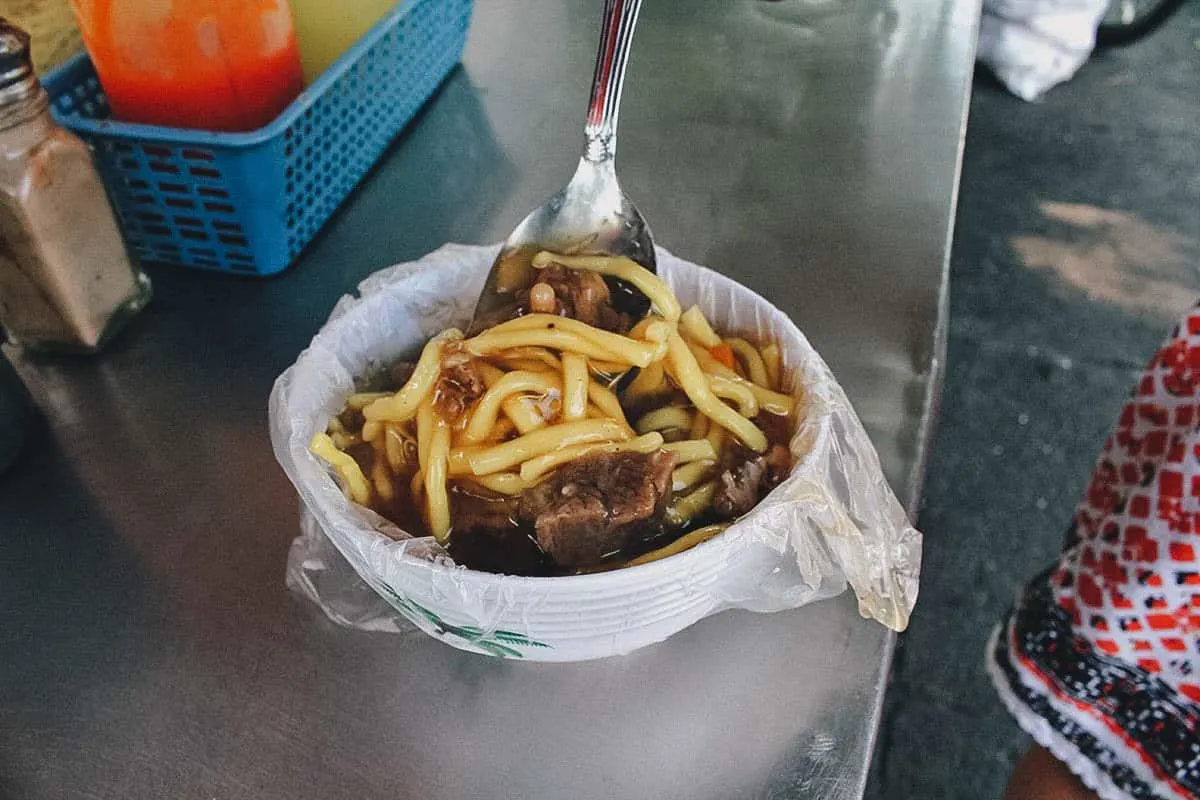
12. Pork BBQ
Pork bbq is one of the most iconic Filipino dishes on this list. Although it’s sold often enough on sidewalk grilleries to merit the label, it’s more than just Filipino street food.
Pork bbq is a Filipino food favorite that’s often found at parties, picnics, and company gatherings. At catered events, you can usually find one chafing dish filled with sticks of pork barbecue.
Most notably, it’s a staple at children’s parties where it’s served alongside other kiddie favorites like Filipino sweet spaghetti and red hot dogs.
Pork bbq are marinated pieces of pork skewered on sticks and grilled over coals. They’re savory-sweet and smokey and often charred in parts so you get those dark crunchy bits like you see below.
A small hunk of fat is typically the last piece at the end of the stick. Many people leave it so you often find plates of used barbecue sticks with just that last piece of fat left. I eat it sometimes, depending on how big it is.
Ren likes to ask people what their hypothetical last meal would be: “If you were to die tomorrow, what would you eat tonight?” More than one person has mentioned pork barbecue. It’s a beloved cultural favorite that goes well beyond the street food label.
RECIPE: Filipino-style pork bbq
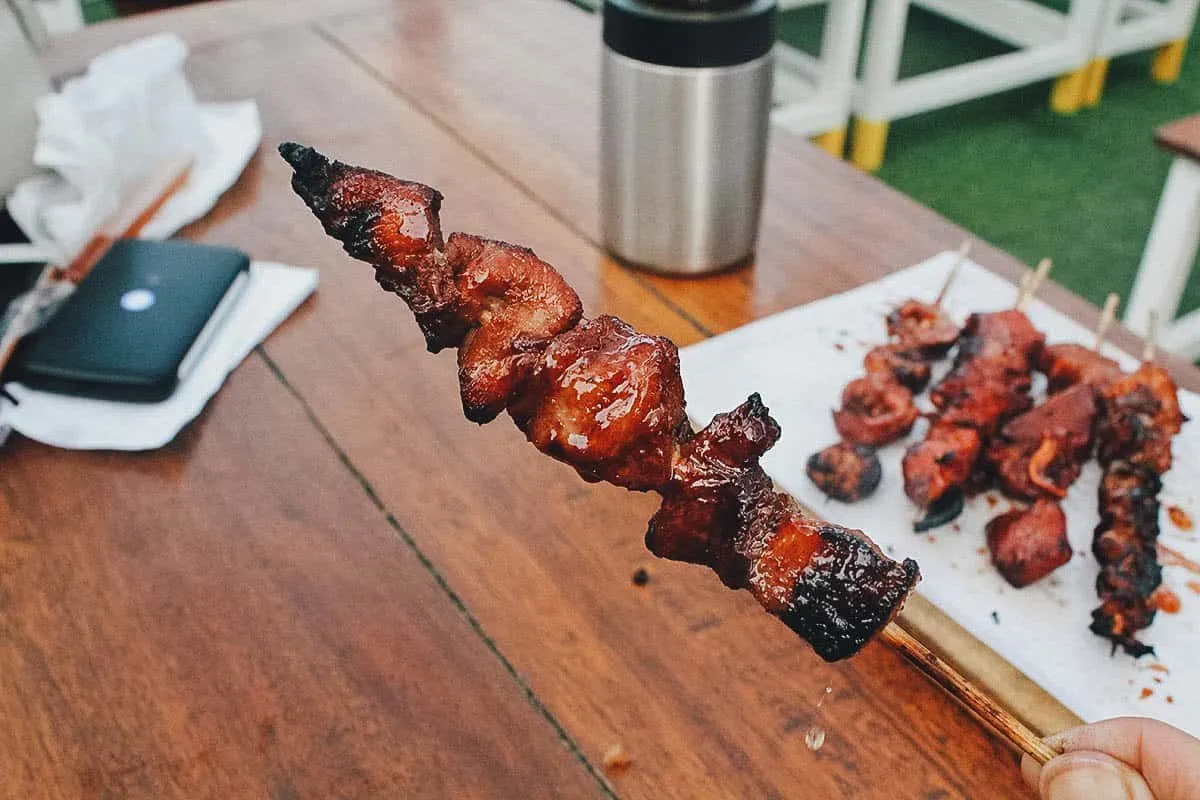
13. Puwet ng Manok
Puwet ng manok is Tagalog for “chicken ass”, which is exactly what these are, skewered marinated pieces of chicken bottoms. If you’ve never had chicken ass before, it’s a fatty piece of chicken meat with a soft strip of cartilage running through it.
Personally, I don’t like it very much. I find it too fatty and unctuous but many people love it. My sister loves it, Ren loves it, everyone else in her family loves it. At parties, we sometimes bring bags full of chicken butts to eat as pulutan or bar chow.
Because every chicken only has one butt, puwet ng manok can be harder to find. Your best bet would be to look for them at small inasal restaurants.
Inasal is the Ilonggo term for “charcoal grilled” and refers to a specific type of skewered marinated grilled chicken. It’s a method of cooking originally from Bacolod but now popular throughout Manila. At inasal restaurants, puwet ng manok is referred to as isol.
RECIPE: Chicken inasal
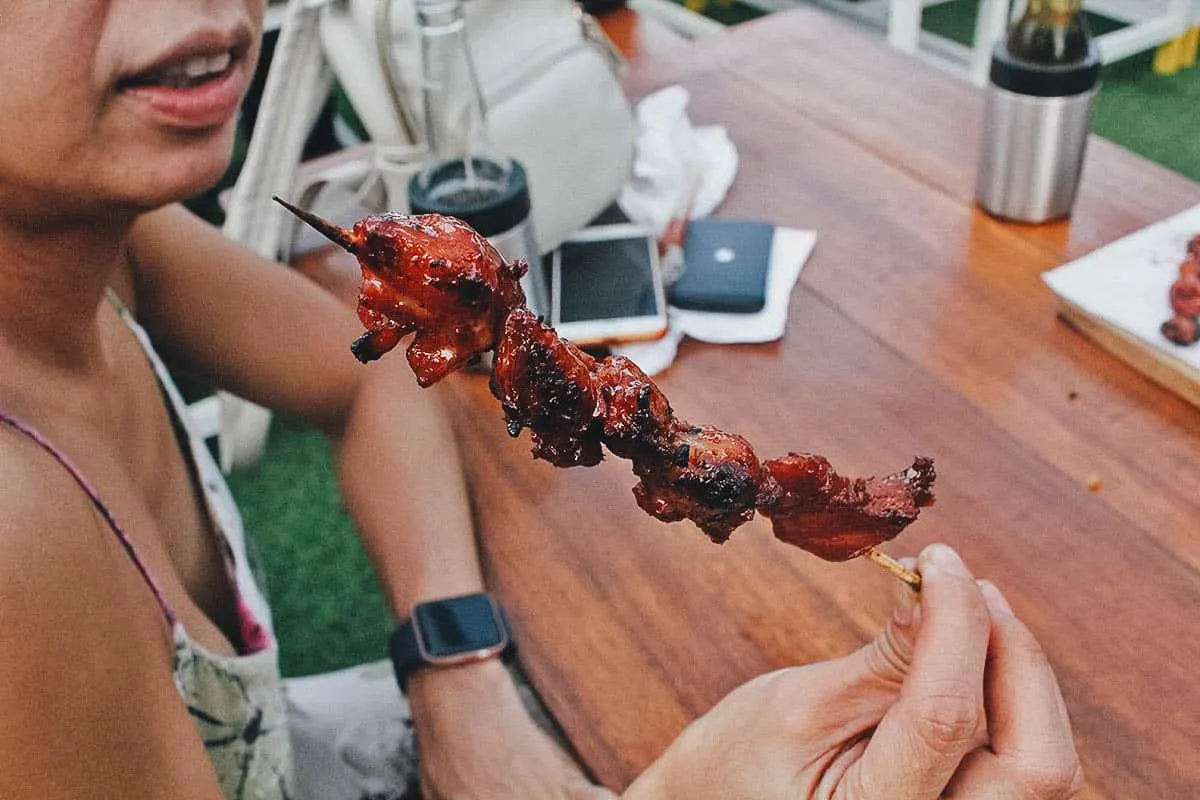
14. Sorbetes (Dirty Ice Cream)
For me, these ice cream pushcarts are as iconic a symbol of Filipino culture as passenger jeepneys. They even look like them with their many colors, patterns, and fancy lettering. I’ve noticed that the wheels are often painted yellow so they resemble the sun in our Philippine flag.
Sorbetes refers to a specific type of ice cream unique to the Philippines. It was traditionally made with carabao’s milk which was cheaper than cow’s milk.
Today, both types of milk are used along with other unique ingredients like coconut milk and cassava flour. Popular sorbetes flavors include mango, strawberry, chocolate, ube, buko, and our personal favorite, queso or cheese.
RECIPE: Sorbetes

Sorbetes is also known colloquially as “dirty ice cream”, likely in reference to the fact that it’s sold as street food in Manila. But the ice cream itself isn’t actually dirty (at least I hope not).
Sorbetes melts faster than factory-made ice cream so be sure to eat it right away. These days, you’ll find commercial ice cream brands churning out a line of sorbetes flavors in honor of this iconic Filipino street food.
They may be superior to the real thing but when it comes to the overall experience, nothing beats eating sorbetes on the side of the street.
Here’s Ren with our cone of queso sorbetes. If you’ve never tried it, you’ll find that it really does taste like cheese! You’ll even get little bits of cheese in the ice cream.
Sorbetes is commonly served in small sugar or waffle cones but it can be served in bread buns as well. We’ve never tried it like that but it actually sounds pretty good. Filipino ice cream sandwich yo!

15. Tenga ng Baboy (Walkman)
Filipinos love giving funny names to things, including food, and this is an example of that. Tenga ng baboy means “pig’s ears” and refers to skewered marinated pieces of sliced pig’s ears, but it’s known colloquially as “walkman” in honor of Sony’s iconic cassette player.
I read that tenga ng baboy became popular as street food around the same time Walkmans were all the rage, hence the name.
Other funny colloquial names for Filipino street food include “helmet”, which refers to grilled chicken heads, and “adidas”, which are grilled chicken feet.
Pig’s ears have a unique texture that we love. It’s a little gummy and chewy but with snap from the cartilage that runs through the meat. It’s really good.
RECIPE: Crispy tenga
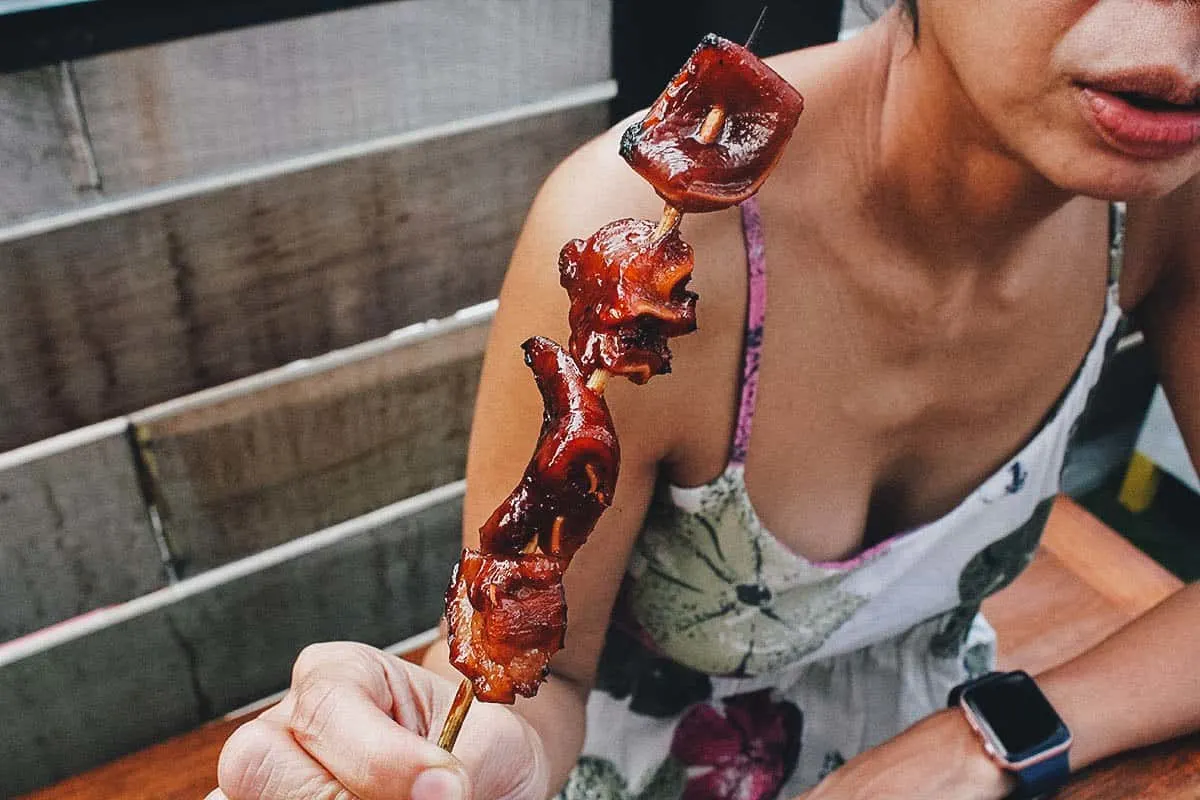
16. Turon
Together with banana q, turon is the most iconic Filipino street food made with sweet plantains. It’s equally beloved as a homemade snack and may even be more popular since it’s lighter on the tummy and a little easier to make.
In our household growing up, I remember turon being served as a midday snack and dessert more often than banana q.
RECIPE: Turon
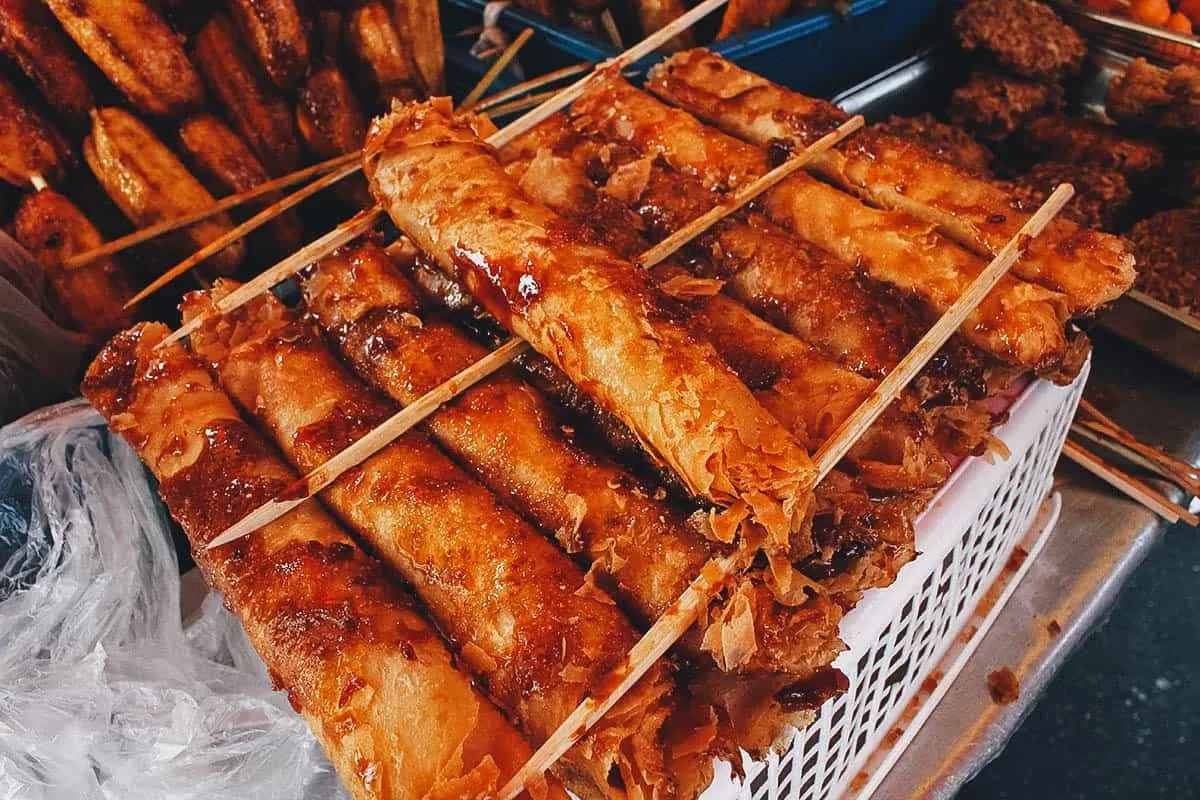
Here’s our turon with that beautiful caramelized brown sugar coating. Turon is made with thinly sliced saba bananas rolled in a spring roll wrapper and dusted with brown sugar before being deep-fried.
This particular version didn’t have any, but turon is often served with a sliver of langka or jackfruit as well. I like that version the best.
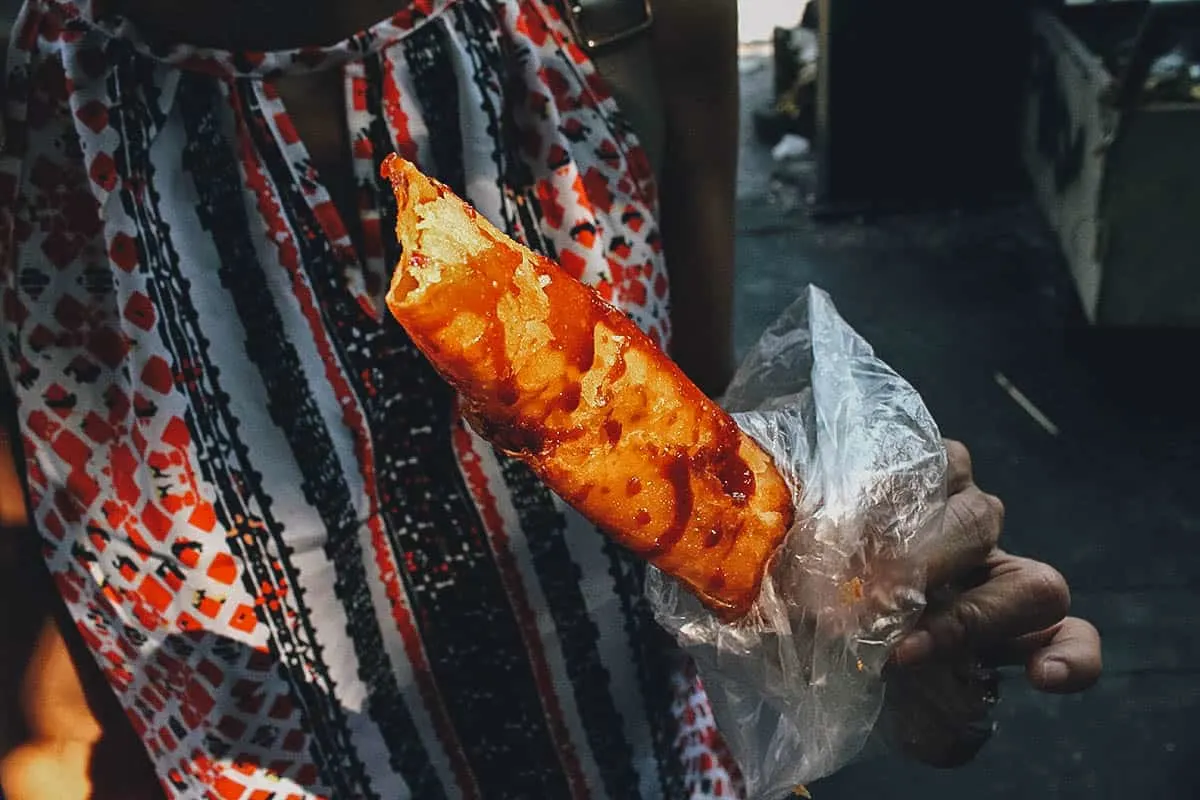
A closer look at that delicious sweet plantain.
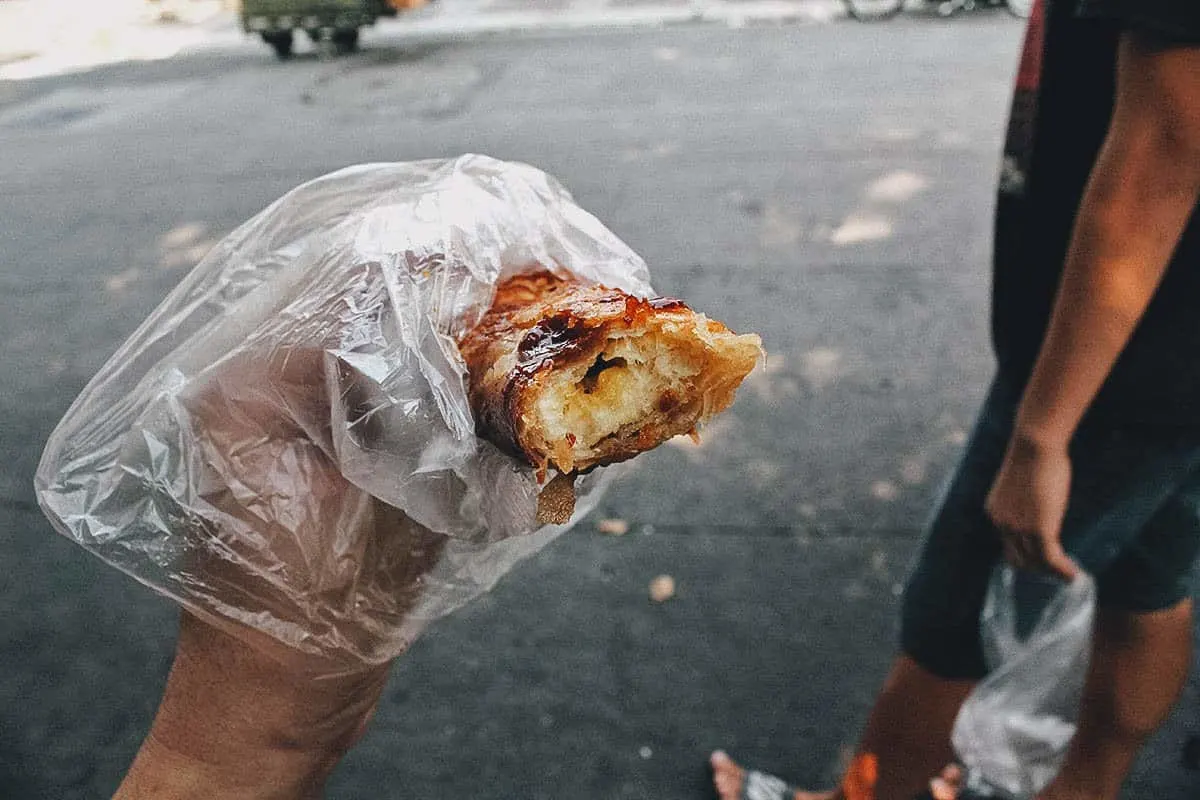
17. Ukoy (Okoy)
Ukoy (or okoy) refers to Filipino shrimp fritters. They’re made with small shrimp, usually with the head and shell still intact, that’s mixed in batter and deep-fried until crispy.
The ukoy we had today only contained shrimp, but many varieties made with vegetables like mung bean sprouts and julienned squash are also popular.
One of the best and most famous regional variants is Vigan ukoy from Ilocos Sur, which is made with glutinous rice flour and spring onions.
RECIPE: Ukoy
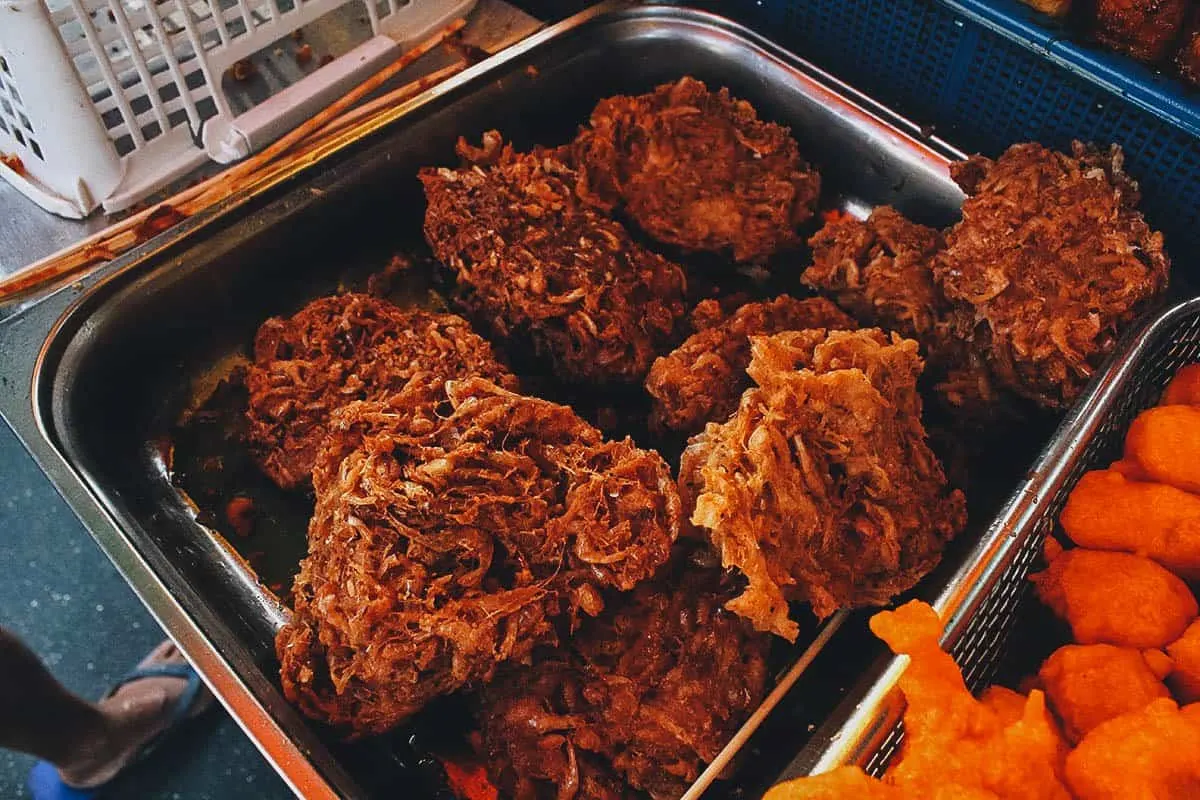
Ukoy is typically eaten with a spiced vinegar to offset the oiliness. It’s a delicious crunchy snack that can be found in many Filipino restaurants as well. Personally, I enjoy eating it with rice.
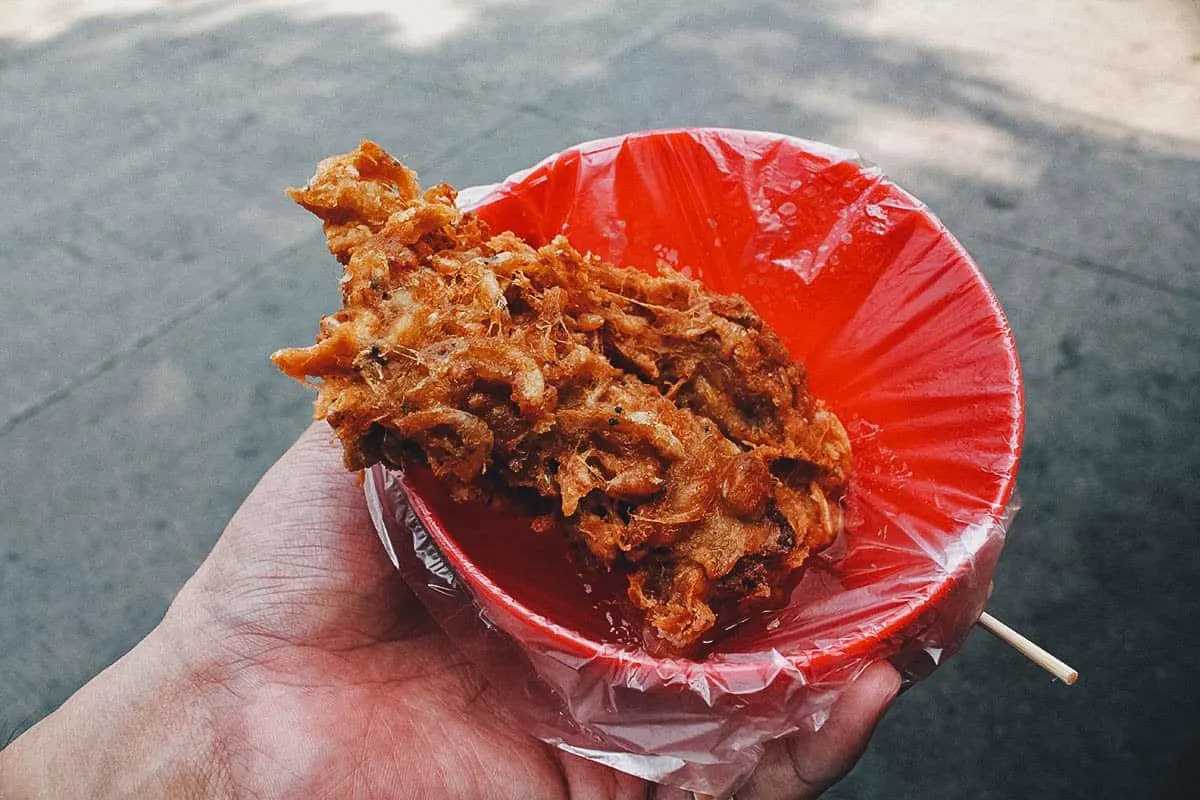
FINAL THOUGHTS ON FILIPINO STREET FOOD
So did we learn anything after this Filipino street food quest? Did we get sick? Did we die? Yes, no, and obviously not.
We learned that Filipino street food isn’t any cleaner or dirtier than street food from other Southeast Asian countries. Were we unfair to write off Filipino street food? Yes. Were our concerns unfounded? I still don’t know.
By nature of the environment, you’d assume that street food isn’t as clean as restaurant food. But this article on street food seems to indicate that the contamination rate from street food is comparable to restaurants.
I don’t know how relevant the numbers are to street food in the Philippines, but I was surprised by the findings considering how the study was done in similar environments like Ghana and Calcutta.
The bottom line is, we have no idea what goes into the production of Filipino street food. We hear the stories and make our assumptions, but at the end of the day, that’s all they are – assumptions.
I’m not saying they’re wrong. But if we don’t have any issues eating street food abroad, then we shouldn’t have any issues eating it here. It’s essentially the same thing.
We had so much fun “gathering data” for this post that it’s a list we plan on growing over time. If you’re familiar with street food in the Philippines, then you’ll know this is by no means a definitive list. Still missing are Filipino street foods like betamax, adidas, helmet, day old, halo-halo, kakanin, taho, and many many more.
Disclosure
Some of the links in this Filipino street food guide are affiliate links, meaning we’ll get a small commission if we make a sale at no added expense to you. We only recommend products and services that we use ourselves and firmly believe in. We really appreciate your support as this helps us make more of these free travel and food guides. Thank you!


N. Bau
Tuesday 10th of January 2023
Great blog! Try also the “bugok” or bibingkang itlog. It’s called bibingkang abnoy here in Manila. Though I prefer more the one being sold in Sta. Cruz, Laguna. It’s not that smelly and tastes really good!
JB & Renée
Thursday 12th of January 2023
Thanks for the recommendation!
Janis
Monday 7th of February 2022
Thank you for sharing a very informative content.
JB & Renée
Friday 11th of February 2022
Our pleasure Janis!
uber eats in philippines
Monday 22nd of November 2021
Great blog! You might want to check mine at uber eats in philippines.
Eric
Tuesday 15th of December 2020
I'm from Manila and I totally agree with what you said in this blog. Street foods are street foods anywhere in Southeast Asian countries. I'm glad you did a blog like this. Great work. Nice read. Great Photos. I love your site. I just started blogging this November. If you have any pointers that you can give me to build my site please do let me know. thank you. would love to hear from you. The blog site is new. I just hope my website would be like yours. thank you
JB & Renée
Thursday 24th of December 2020
Thank you Eric! :)
kate
Tuesday 1st of December 2020
Nice post you must try that street foods it's yummy.
JB & Renée
Thursday 10th of December 2020
@Kate: Yes for sure!